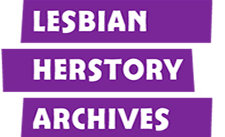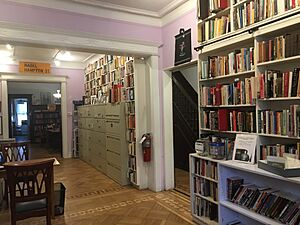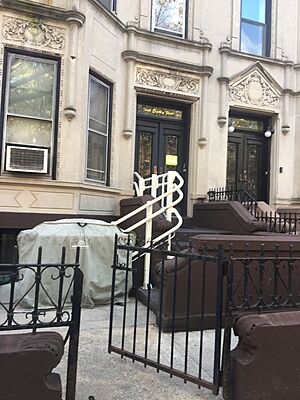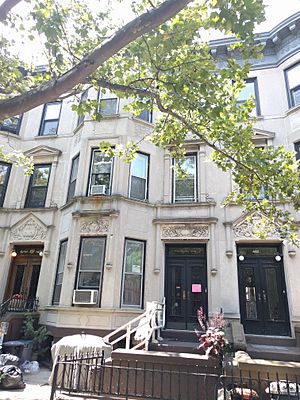Lesbian Herstory Archives facts for kids

Logo
|
|
| Established | 1974 |
|---|---|
| Location | 484 14th St. Park Slope, Brooklyn, New York 11215 |
| Type | Archive, history museum |
| Public transit access |
|
| Designated | November 22, 2022 |
| Reference no. | 2662 |
The Lesbian Herstory Archives (LHA) is a special place in New York City. It's like a museum and a community center all in one. Its main goal is to save and share the stories and experiences of women who love women.
Located in Park Slope, Brooklyn, the Archives hold the world's largest collection of items by and about these women. It's a treasure chest of history! The Archives were started in 1974 by a group of women who wanted to make sure their stories were not forgotten. The people who work there are often called "archivettes," which is a fun twist on the word "archivist." There's even a documentary called "The Archivettes" that tells their amazing story.
Contents
Discovering the Archives' Story
How the Archives Began
After important events in 1969 that helped people speak up for their rights, many groups were formed. The Lesbian Herstory Archives started because people wanted to make sure the history of women who love women was saved. They wanted to tell their own stories, not have them told by others.
One of the founders, Joan Nestle, said the Archives began because people found their courage to speak out. The motto of the Archives is "In memory of the voices we have lost." This means they want to remember and honor all the stories that might have been forgotten.
The founders included Joan Nestle, Deborah Edel, Sahli Cavallo, Pamela Oline, and Julia Penelope Stanley. They started collecting all kinds of things related to the lives of women who love women. They collected items from famous people and everyday people alike. They even joked that if an object was touched by a woman who loved women, they would collect it!
The Archives first opened in 1974 in Joan Nestle's apartment pantry. This first location was later recognized as a special historic site in Manhattan.
Growing and Moving to a New Home
The LHA started a newsletter in 1975 to share updates. In 1979, it became a non-profit organization, which means it's a group that helps the community without making money. The collection grew very quickly! By 1990, it had thousands of books, photos, and other items.
Because the collection got so big, the Archives needed a new, larger home. They started raising money in 1985, often through fun events like ping-pong tournaments and barbecues.
A Landmark Building in Brooklyn
After many years of fundraising, the LHA bought a three-story brownstone house in Park Slope in 1991. They hired women carpenters and architects to turn the house into a perfect home for their collection. The Archives moved to this new building in 1992, and it officially opened in 1993.
By 1995, the collection had 10,000 books, including very old ones and popular stories from the mid-1900s. The newsletter also had 6,000 readers! The mortgage for the building was paid off by 1996.
In November 2022, the New York City Landmarks Preservation Commission made the Archives' building an official city landmark. This was a very important moment because it was the first building in Brooklyn recognized for its importance to the LGBTQ+ community.
How the Archives Work
The Lesbian Herstory Archives are run by a group of people who decide what new items to add. The Archives are completely staffed by volunteers and interns who give their time to help.
The LHA also hosts many events, like classes, speakers, poetry readings, and a special Valentine's Day event every year. People from the Archives often march in parades to celebrate and share their message.
In the past, they would bring samples of their collection to talks. Now, they have traveling exhibits that focus on different themes. For example, their "Keepin' On" exhibit highlights the stories of African American women who love women.
What You Can Find in the Collections
The Archives started with personal items donated by the founders. This includes everything written by founder Joan Nestle. They asked others to donate items, and the collection grew steadily.
When you visit the LHA, you can see almost everything in the collection. A few items are kept private if the donors asked for it. Visitors need to make appointments and can only view items there. You can't take pictures inside to protect the items.
Today, the collection has all sorts of historical items. These include papers, diaries, journals, photographs, tapes, posters, buttons, magazines, homemade books (called zines), T-shirts, and videos. You can watch films at the Archives, and the original copies are kept safe in a special storage facility. Books are organized by the authors' first names, which is a unique way to do it!
Many people have donated important items to the LHA. For example, activist Mabel Hampton gave her large collection of stories to the Archives in 1976. Other organizations have also donated their files when they closed. The Archives also has the "Red Dot Collection," which is the library of the first national organization for women who love women in the United States. Famous writer and activist Audre Lorde donated some of her writings and personal papers.
The LHA launched its website in 1997. It now has a digital collection where you can take a virtual tour of the Archives. They have also put many photographs, newsletters, and videos online. The LHA is still working to digitize more of its audio and newspaper collections.
The Archives Building
The LHA's home is a beautiful three-story house at 484 14th Street in Brooklyn. It was designed in 1908 and was originally a two-family house. Over the years, different families lived there, including immigrants from Germany, Hungary, and Syria.
The outside of the house is mostly made of limestone, with a brownstone base. You enter through a stoop (a small set of steps) on the right side. The main door is made of glass and wood, with pretty carvings above it. The building has many interesting details, like decorative windows and a fancy metal trim at the top.
After the LHA bought the building in 1991, they changed the first two floors to hold their displays and storage. The main archives are on the first floor, with custom-made shelves, offices, a kitchen, and a space for events. There's also a wheelchair lift to make it accessible for everyone. A caretaker lives on the third floor.
Images for kids
More to Explore
- GLBT Historical Society
- June L. Mazer Lesbian Archives
- LGBT culture in New York City
- ONE National Gay & Lesbian Archives
- List of New York City Designated Landmarks in Brooklyn
See also
 In Spanish: Lesbian Herstory Archives para niños
In Spanish: Lesbian Herstory Archives para niños






